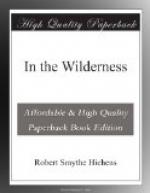intent on the lily-pads of the pond; the raccoon and
the hedgehog, sidling along; and the velvet-footed
panther, insouciant and conscienceless, scenting the
path with a curious glow in his eye, or crouching in
an overhanging tree ready to drop into the procession
at the right moment. Night and day, year after
year, I see them going by, watched by the red fox and
the comfortably clad sable, and grinned at by the black
cat,—the innocent, the vicious, the timid
and the savage, the shy and the bold, the chattering
slanderer and the screaming prowler, the industrious
and the peaceful, the tree-top critic and the crawling
biter,—just as it is elsewhere. It
makes me blush for my species when I think of it.
This charming society is nearly extinct now: of
the larger animals there only remain the bear, who
minds his own business more thoroughly than any person
I know, and the deer, who would like to be friendly
with men, but whose winning face and gentle ways are
no protection from the savageness of man, and who
is treated with the same unpitying destruction as
the snarling catamount. I have read in history
that the amiable natives of Hispaniola fared no better
at the hands of the brutal Spaniards than the fierce
and warlike Caribs. As society is at present
constituted in Christian countries, I would rather
for my own security be a cougar than a fawn.
There is not much of romantic interest in the Adirondacks.
Out of the books of daring travelers, nothing.
I do not know that the Keene Valley has any history.
The mountains always stood here, and the Au Sable,
flowing now in shallows and now in rippling reaches
over the sands and pebbles, has for ages filled the
air with continuous and soothing sounds. Before
the Vermonters broke into it some three-quarters of
a century ago, and made meadows of its bottoms and
sugar-camps of its fringing woods, I suppose the red
Indian lived here in his usual discomfort, and was
as restless as his successors, the summer boarders.
But the streams were full of trout then, and the moose
and the elk left their broad tracks on the sands of
the river. But of the Indian there is no trace.
There is a mound in the valley, much like a Tel in
the country of Bashan beyond the Jordan, that may
have been built by some pre-historic race, and may
contain treasure and the seated figure of a preserved
chieftain on his slow way to Paradise. What the
gentle and accomplished race of the Mound-Builders
should want in this savage region where the frost kills
the early potatoes and stunts the scanty oats, I do
not know. I have seen no trace of them, except
this Tel, and one other slight relic, which came to
light last summer, and is not enough to found the
history of a race upon.




